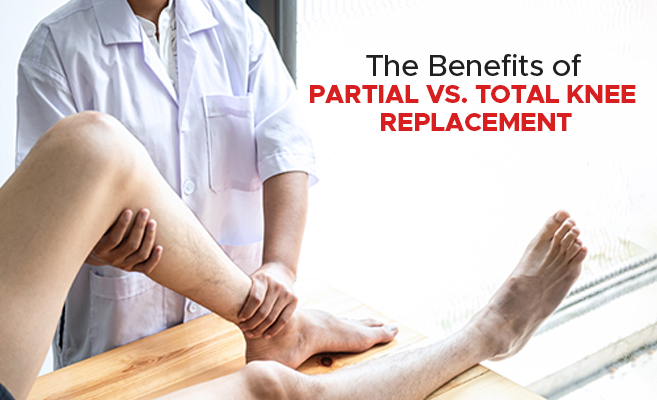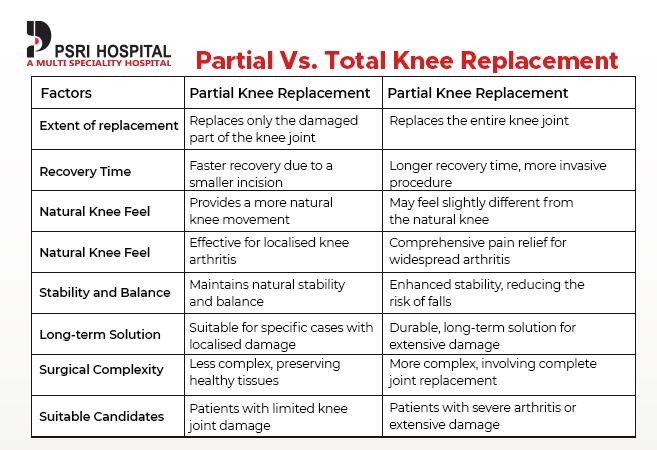The Benefits of Partial vs. Total Knee Replacement

Have you ever wondered about the best solution for your knee pain? You’re not alone! Many people are confused about whether to choose partial or total knee replacement surgery. But how do you decide? Well, let’s dive in together!
Both the options of knee replacement have their own set of advantages and considerations. In this blog post, we will break down the benefits of partial vs. total knee replacement, helping you make an informed decision about your knee health.
Partial Vs. Total Knee Replacement
First, let’s understand the basic difference between both types of knee replacement to get a better understanding.

What is Partial Knee Replacement?
Unicompartmental knee arthroplasty, another name for partial knee replacement, is a surgical treatment that only replaces the damaged portion of the knee joint. Patients with localised knee arthritis—where only a small portion of the knee is affected—should consider this method of treatment.
Benefits of Partial Knee Replacement
- Faster Recovery: When compared to total knee replacement, partial knee replacement typically requires a smaller incision and preserves healthy tissue.
- Natural Knee Feel: Patients frequently experience more natural knee mobility and function after surgery because only the damaged part is replaced.
- Lower Risk of Complications: There is a lower risk of complications, including infections and blood clots, with a less intrusive technique.
What is Total Knee Replacement?
The entire knee joint is replaced with synthetic components in a total knee replacement, also known as a total knee arthroplasty. Patients with severe degeneration of the joints or widespread knee arthritis are frequently advised to have this operation.
Benefits of Total Knee Replacement:
- Comprehensive Pain Relief: Total knee replacement provides complete pain relief for patients suffering from extensive knee arthritis, allowing them to regain an active lifestyle.
- Improved Stability: By replacing the entire joint, total knee replacement enhances stability and balance, reducing the risk of falls and improving overall mobility.
- Long-Term Solution: Total knee replacement is a durable, long-term solution, offering patients years of improved joint function and pain-free living.
Partial vs. Total Knee Replacement – Choosing the Right Option?
Deciding between partial and total knee replacement depends on various factors, including the extent of joint damage, overall health, and the surgeon’s recommendation. It’s important to seek advice from a reputable orthopaedic doctor from a knee replacement hospital in Delhi who can evaluate your issue and direct you toward the best solution for your unique requirements.
Conclusion
Partial vs. total knee injuries replacement is a choice that requires careful consideration. Understanding the benefits of each option empowers you to collaborate effectively with your healthcare provider, ensuring you receive the best possible treatment tailored to your condition.
Both partial and total knee replacements have a high percentage of success, considerably enhancing the quality of life for millions of people throughout the world. Keep in mind that your orthopaedic surgeon is your best partner on this journey, offering individualised direction and assistance at every turn.
So, if you are looking for the best knee replacement hospital in Delhi, go nowhere other than PSRI Hospital. We have the best team of orthopaedic doctors who can treat you according to your requirements and suggest the best course of action.
FAQs
FAQ 1: What is the main difference between partial and total knee replacement?
Answer: Partial knee replacement involves replacing only the damaged part of the knee joint, while total knee replacement replaces the entire knee joint with artificial components. The choice depends on the extent of the knee damage and your surgeon’s recommendation.
FAQ 2: Is recovery faster with partial knee replacement?
Answer: Yes, recovery is generally faster with partial knee replacement. The procedure involves a smaller incision and preserves healthy tissues, leading to a quicker recovery time compared to total knee replacement.
FAQ 3: Will my knee feel natural after the surgery?
Answer: With partial knee replacement, patients often experience a more natural knee movement and function since only the damaged portion is replaced. Total knee replacement provides comprehensive pain relief, but the knee might feel slightly different from the natural one.
FAQ 4: Who is a suitable candidate for partial knee replacement?
Answer: Partial knee replacement is suitable for patients with localised knee arthritis or specific cases where only one part of the knee is affected. It’s best suited for individuals with limited knee joint damage and can preserve healthy tissues.
FAQ 5: How long can I expect the results of knee replacement to last?
Answer: Both partial and total knee replacements are durable solutions. Partial knee replacements provide long-term relief for localised damage. In contrast, total knee replacements offer comprehensive pain relief and improved joint function for many years, allowing patients to lead active lives without constant pain.

 Book An Appointment
Book An Appointment Virtual Consultation
Virtual Consultation




